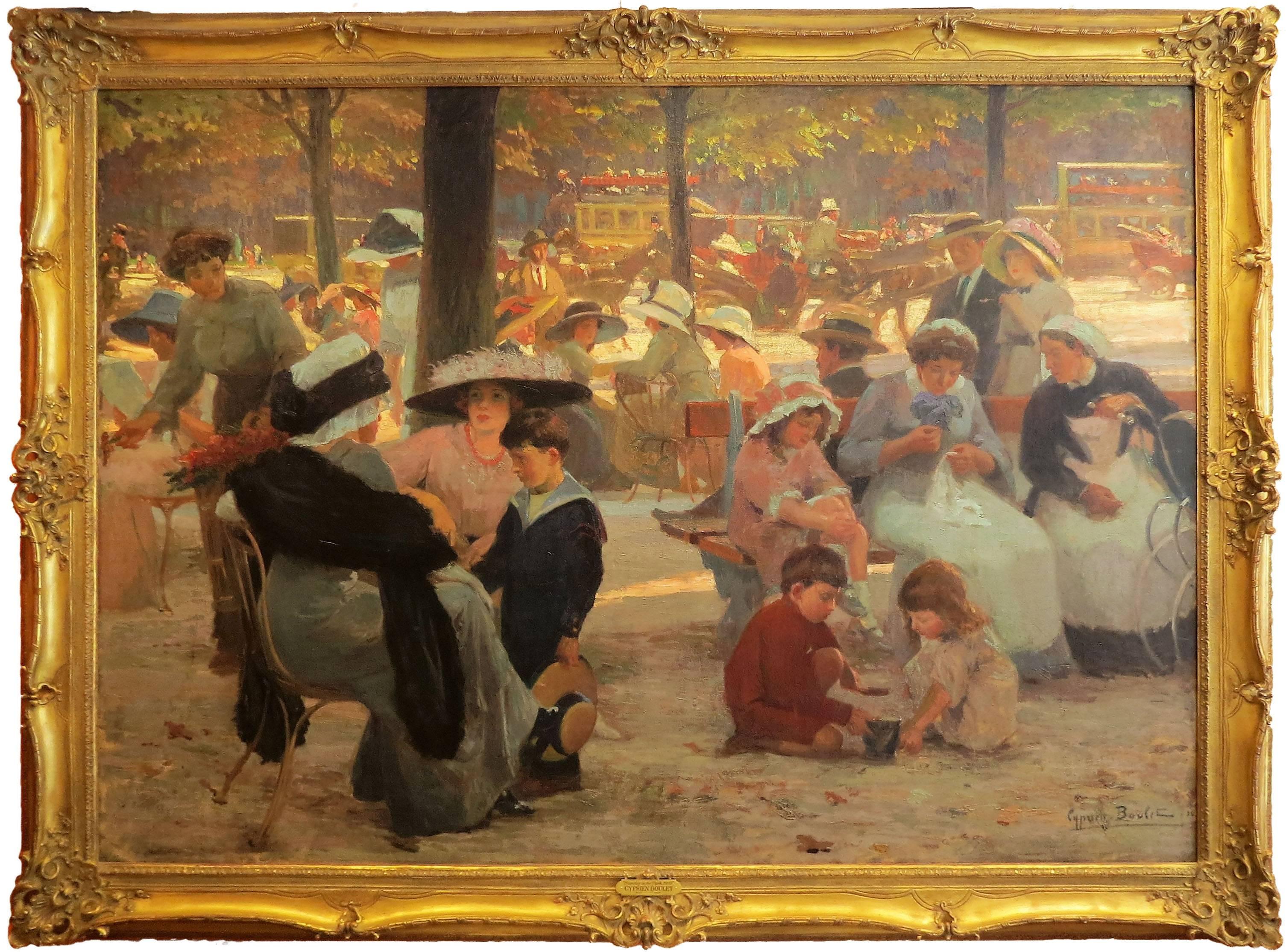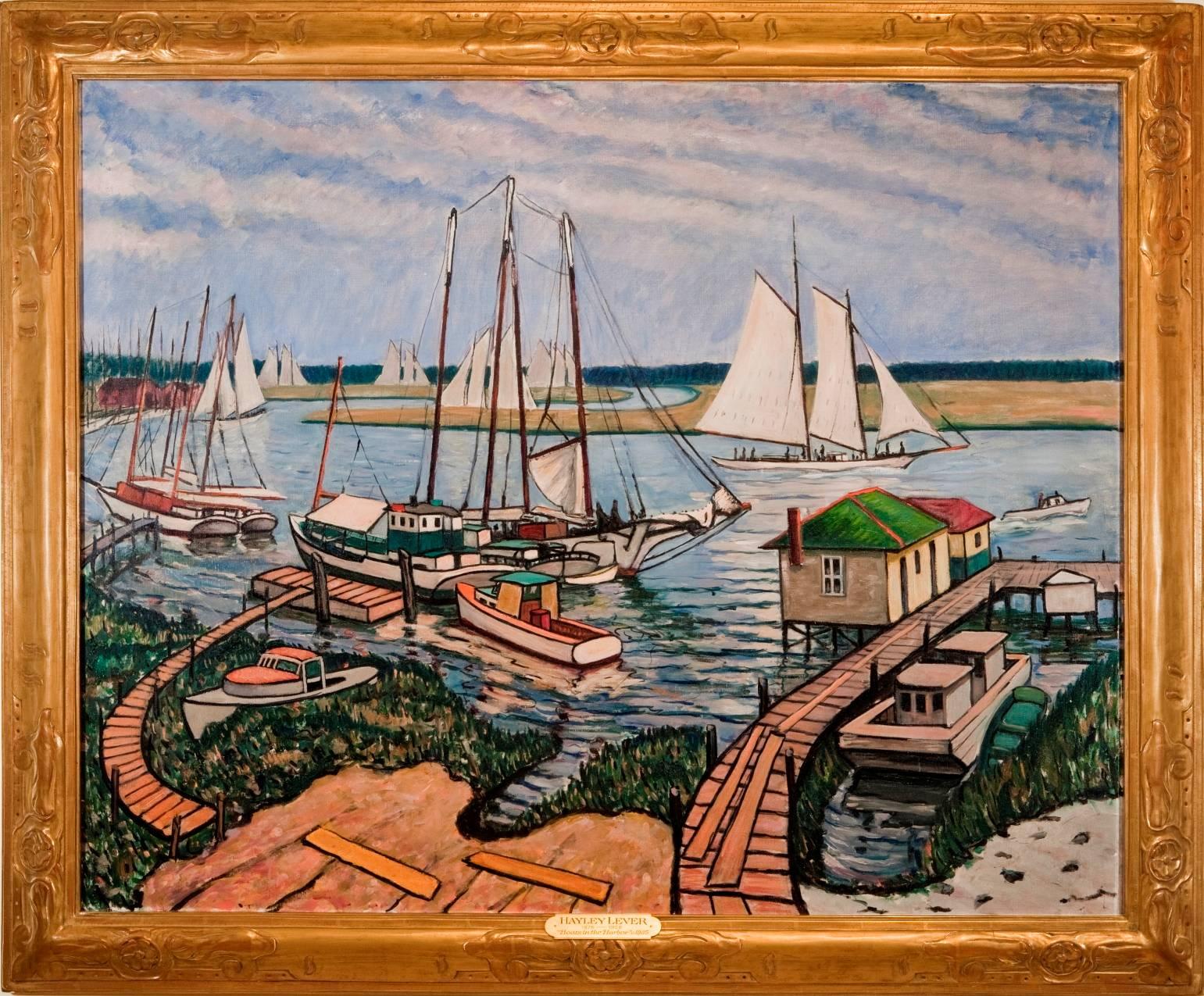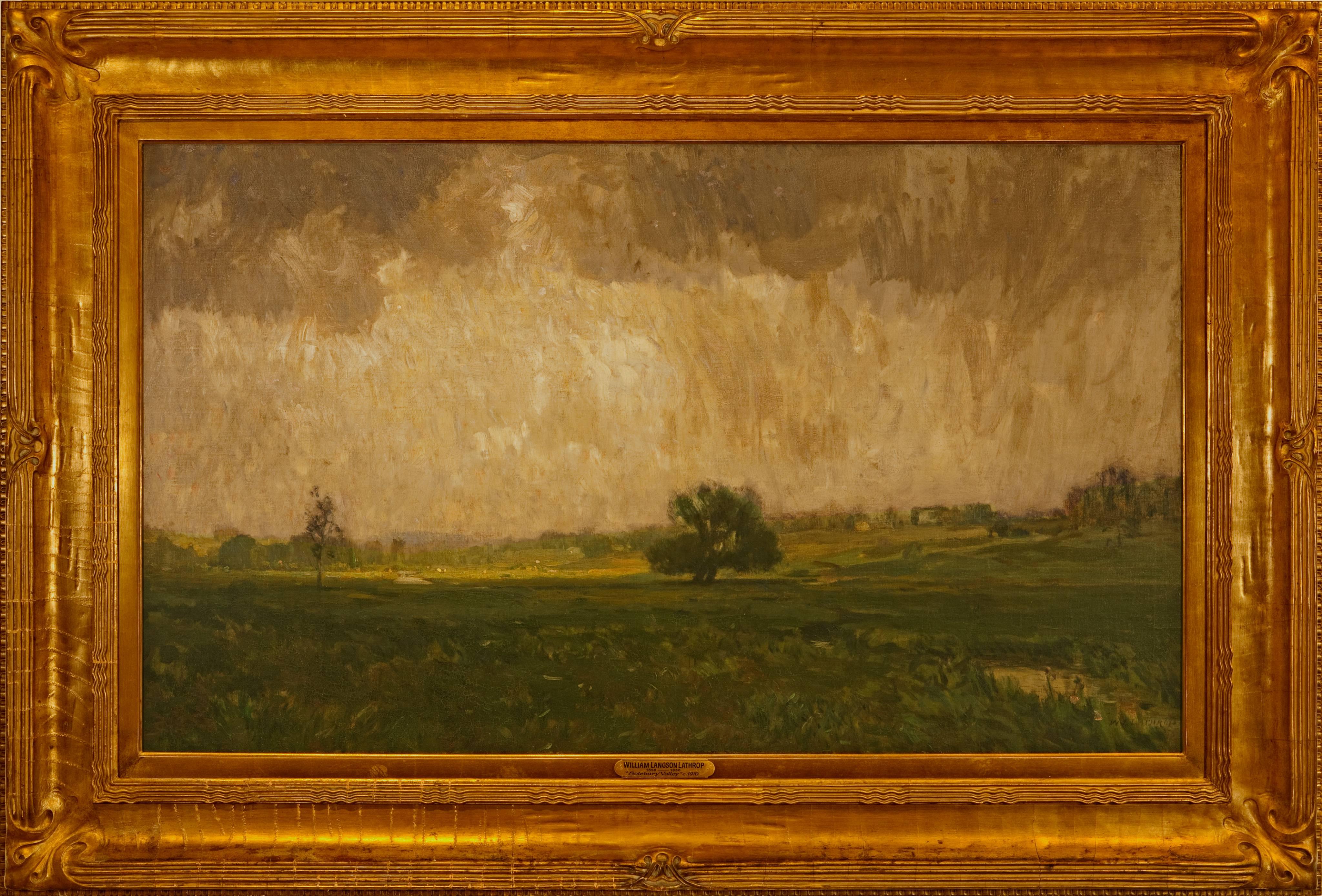Want more images or videos?
Request additional images or videos from the seller
1 of 10
Abraham Jacob Bogdanove"Seascape Monhegan"
About the Item
Signed
Born in Minsk, Russia, Abraham Bogdanove was a landscape, seascape and portrait painter who is best known for his images of Monhegan Island, off the coast of Maine. He also painted in Europe and in Canada at the Gaspe Peninsula.
Bogdanove studied in New York at the Art Students League, Cooper Union, the National Academy of Design, and Columbia University School of Architecture where he trained with and was studio assistant to the noted muralist, Francis Millet.
Between 1913 and 1930, Bogdanove completed numerous murals including historical scenes relating to the founding of America and commissions for numerous New York area school. During this time, he was devoting much time to his fine-art painting.
He visited Maine for the first time in 1915, when he spent a summer at Seal Harbor on Mount Desert Island. There he was inspired by the dramatic vistas of mountains plunging to the sea that had been painted by Frederic E. Church and Fitz Hugh Lane, and participated in the town’s social scene to which he was introduced by his friend, Clara Clemens, the daughter of Mark Twain. At the afternoon teas she hosted, Bogdanove met John D. Rockefeller and the actor John Barrymore, among others.
By 1918, the refinements of summer life on Mount Desert had lost their attraction for Bogdanove, and seeking a rougher locale, he found his way to Monhegan, a tiny island seventeen miles off the midcoast of Maine. Instead of mountainous scenery, Monhegan offered a compact and varied landscape, unique among the hundreds of islands that dot Maine’s coastal waters. Less than two miles long and a mile wide, the island includes a picturesque harbor lined with fish houses, rolling meadows, pine woods, and cliffs soaring two hundred feet above the open ocean.
Among the other artists who had spent time on Monhegan were Robert Henri, George Bellows, Rockwell Kent, and Edward Hopper, and on the island, Bogdanove joined a colony of artists who sought to escape the urban world for a remote and picturesque locale that was highly paintable. On the island, Bogdanove found a subject worthy of sustained focus. After a captivating first encounter, he returned every summer for the rest of his life. In 1935, he expressed his delight in his time on Monhegan, stating:
"There are a number of reasons why I prefer Monhegan to all other places on the Atlantic Coast. It is so far from the mainland that we are not disturbed by the outer world and there are no social demands. The cliffs here are so bold and precipitous and the studies offered by the island shore so inexhaustible. The climate suits me. Perhaps because it is more like that of Russia, where my ancestors lived. "
For twenty-two years he taught drawing, painting, and anatomy at the New York School of Industrial Art, and from 1919 to 1942 at City College of New York. Following his retirement in 1942, he moved to Dunbarton, New Hampshire.
He exhibited widely including at the Metropolitan Museum, the National Academy of Design, and the Corcoran Gallery of Art.
- Creator:Abraham Jacob Bogdanove (1887-1946, American)
- Dimensions:Height: 39 in (99.06 cm)Width: 45 in (114.3 cm)Depth: 3 in (7.62 cm)
- Medium:
- Movement & Style:
- Period:
- Condition:
- Gallery Location:Lambertville, NJ
- Reference Number:
About the Seller
5.0
Vetted Seller
These experienced sellers undergo a comprehensive evaluation by our team of in-house experts.
1stDibs seller since 2013
12 sales on 1stDibs
- ShippingRetrieving quote...Ships From: Lambertville, NJ
- Return PolicyThis item cannot be returned.
More From This SellerView All
- "Sunday in the Park, 1910"By Cyprien Eugène BouletLocated in Lambertville, NJSigned Lower Right Cyprien-Eugène Boulet (1877 - 1927)Category
Early 20th Century Impressionist Landscape Paintings
MaterialsCanvas, Oil
- "Boats in the Harbor"By Hayley LeverLocated in Lambertville, NJOriginal Period Frame Hayley Lever (1876 - 1958) Hayley Lever's exceptional career path took him from the shores of his native Australia to those of England, and then the United S...Category
1930s Impressionist Landscape Paintings
MaterialsCanvas, Oil
- "The Gentleman"By Carle John BlennerLocated in Lambertville, NJAshley John is proud to offer this artwork by: Carle Blenner (1862 - 1952) Carle Blenner was born in Richmond, Virginia, and received his education in Marburg, Germany. Blenner re...Category
Early 20th Century Impressionist Figurative Paintings
MaterialsOil, Canvas
- "Overhanging Trees"By Julian Alden WeirLocated in Lambertville, NJAshley John is proud to offer this artwork by: J Alden Weir (1852 - 1919) Born in West Point, New York Julian Alden Weir received his first art training from his father, Robert W....Category
Late 19th Century American Impressionist Landscape Paintings
MaterialsOil, Canvas
- "Heavy Sea"By Abraham Jacob BogdanoveLocated in Lambertville, NJSigned LR, View of Gull Rock - Monhegan Born in Minsk, Russia, Abraham Bogdanove was a landscape, seascape and portrait painter who is best known for his images of Monhegan Island, off the coast of Maine. He also painted in Europe and in Canada at the Gaspe Peninsula. Bogdanove studied in New York at the Art Students League, Cooper Union, the National Academy of Design, and Columbia University School of Architecture where he trained with and was studio assistant to the noted muralist, Francis Millet...Category
20th Century Impressionist Landscape Paintings
MaterialsOil, Panel
- "St. Ives, Cornwall, England"By Hayley LeverLocated in Lambertville, NJBorn in Adelaide, Australia, Hayley Lever was known for his town-shore landscapes and still-life painting in a style that combined impressionism with vivid colors and strong lines of...Category
Early 1900s Impressionist Landscape Paintings
MaterialsOil, Panel
You May Also Like
- "Alley Fiends"By John R. GrabachLocated in Lambertville, NJJim’s of Lambertville is proud to offer this artwork by: John R. Grabach (1886 - 1981) John Grabach was a highly regarded New Jersey artist, teacher, and author of the classic text...Category
1930s American Impressionist Landscape Paintings
MaterialsCanvas, Oil
- "Forest Strongholds"By John F. CarlsonLocated in Lambertville, NJSigned lower right. Complemented by a hand carved and gilt frame. Exhibited at the National Academy of Design, 1928Category
20th Century American Impressionist Landscape Paintings
MaterialsCanvas, Oil
- "Solebury Valley"By William Langson LathropLocated in Lambertville, NJSigned lower right. Complemented by a period frame. William L. Lathrop (1859-1938) Deemed “Father of the New Hope Art Colony”, William Langson Lathrop was born in Warren, Illinois. He was largely self-taught, having only studied briefly with William Merritt Chase in 1887, at the Art Students League. Lathrop first moved east in the early 1880s, and took a job at the Photoengraving Company in New York City. While there, he befriended a fellow employee, Henry B. Snell. The two men became lifelong friends and ultimately, both would be considered central figures among the New Hope Art Colony. Lathrop's early years as an artist were ones of continuing struggle. His efforts to break through in the New York art scene seemed futile, so he scraped enough money together to travel to Europe with Henry Snell in1888. There he met and married an English girl, Annie Burt. Upon returning to New York, he tried his hand at etching, making tools from old saw blades...Category
1910s American Impressionist Landscape Paintings
MaterialsCanvas, Oil
- Winter MoonlightBy George William SotterLocated in Lambertville, NJsigned lower rightCategory
1910s American Impressionist Landscape Paintings
MaterialsCanvas, Oil
- "The Canal"By Edward Willis RedfieldLocated in Lambertville, NJJim’s of Lambertville is proud to offer this artwork. Signed lower left. Complemented by a hand carved and gilt frame. Illustrated in "Edward Redfield: Just Values and Fine Seeing" by Constance Kimmerle and the Pennsylvania Academy of the Fine Arts's Exhibition of Paintings by Edward Redfield (April 17 to May 16, 1909) brochure Edward Willis Redfield (1869 - 1965) Edward W. Redfield was born in Bridgeville, Delaware, moving to Philadelphia as a young child. Determined to be an artist from an early age, he studied at the Spring Garden Institute and the Franklin Institute before entering the Pennsylvania Academy from 1887 to 1889, where he studied under Thomas Anshutz, James Kelly, and Thomas Hovenden. Along with his friend and fellow artist, Robert Henri, he traveled abroad in 1889 and studied at the Academie Julian in Paris under William Bouguereau and Tony Robert-Fleury. While in France, Redfield met Elise Deligant, the daughter of an innkeeper, and married in London in 1893. Upon his return to the United States, Redfield and his wife settled in Glenside, Pennsylvania. He remained there until 1898, at which time he moved his family to Center Bridge, a town several miles north of New Hope along the Delaware River. Redfield painted prolifically in the 1890s but it was not until the beginning of the twentieth century that he would develop the bold impressionist style that defined his career. As Redfield’s international reputation spread, many young artists gravitated to New Hope as he was a great inspiration and an iconic role model. Edward Redfield remained in Center Bridge throughout his long life, fathering his six children there. Around 1905 and 1906, Redfield’s style was coming into its own, employing thick vigorous brush strokes tightly woven and layered with a multitude of colors. These large plein-air canvases define the essence of Pennsylvania Impressionism. By 1907, Redfield had perfected his craft and, from this point forward, was creating some of his finest work. Redfield would once again return to France where he painted a small but important body of work between 1907 and 1908. While there, he received an Honorable Mention from the Paris Salon for one of these canvases. In 1910 he was awarded a Gold Medal at the prestigious Buenos Aires Exposition and at the Panama-Pacific Exposition of 1915 in San Francisco, an entire gallery was dedicated for twenty-one of his paintings. Since Redfield painted for Exhibition with the intent to win medals, his best effort often went into his larger paintings. Although he also painted many fine smaller pictures, virtually all of his works were of major award-winning canvas sizes of 38x50 or 50x56 inches. If one were to assign a period of Redfield’s work that was representative of his “best period”, it would have to be from 1907 to 1925. Although he was capable of creating masterpieces though the late 1940s, his style fully matured by 1907 and most work from then through the early twenties was of consistently high quality. In the later 1920s and through the 1930s and 1940s, he was like most other great artists, creating some paintings that were superb examples and others that were of more ordinary quality. Redfield earned an international reputation at a young age, known for accurately recording nature with his canvases and painting virtually all of his work outdoors; Redfield was one of a rare breed. He was regarded as the pioneer of impressionist winter landscape painting in America, having few if any equals. Redfield spent summers in Maine, first at Boothbay Harbor and beginning in the 1920s, on Monhegan Island. There he painted colorful marine and coastal scenes as well as the island’s landscape and fishing shacks. He remained active painting and making Windsor style furniture...Category
Early 1900s American Impressionist Landscape Paintings
MaterialsCanvas, Oil
- "In Port"By Edward Willis RedfieldLocated in Lambertville, NJJim’s of Lambertville is proud to offer this artwork by: Edward Willis Redfield (1869 - 1965) Edward W. Redfield was born in Bridgeville, Delaware, moving to Philadelphia as a young child. Determined to be an artist from an early age, he studied at the Spring Garden Institute and the Franklin Institute before entering the Pennsylvania Academy from 1887 to 1889, where he studied under Thomas Anshutz, James Kelly, and Thomas Hovenden. Along with his friend and fellow artist, Robert Henri, he traveled abroad in 1889 and studied at the Academie Julian in Paris under William Bouguereau and Tony Robert-Fleury. While in France, Redfield met Elise Deligant, the daughter of an innkeeper, and married in London in 1893. Upon his return to the United States, Redfield and his wife settled in Glenside, Pennsylvania. He remained there until 1898, at which time he moved his family to Center Bridge, a town several miles north of New Hope along the Delaware River. Redfield painted prolifically in the 1890s but it was not until the beginning of the twentieth century that he would develop the bold impressionist style that defined his career. As Redfield’s international reputation spread, many young artists gravitated to New Hope as he was a great inspiration and an iconic role model. Edward Redfield remained in Center Bridge throughout his long life, fathering his six children there. Around 1905 and 1906, Redfield’s style was coming into its own, employing thick vigorous brush strokes tightly woven and layered with a multitude of colors. These large plein-air canvases define the essence of Pennsylvania Impressionism. By 1907, Redfield had perfected his craft and, from this point forward, was creating some of his finest work. Redfield would once again return to France where he painted a small but important body of work between 1907 and 1908. While there, he received an Honorable Mention from the Paris Salon for one of these canvases. In 1910 he was awarded a Gold Medal at the prestigious Buenos Aires Exposition and at the Panama-Pacific Exposition of 1915 in San Francisco, an entire gallery was dedicated for twenty-one of his paintings. Since Redfield painted for Exhibition with the intent to win medals, his best effort often went into his larger paintings. Although he also painted many fine smaller pictures, virtually all of his works were of major award-winning canvas sizes of 38x50 or 50x56 inches. If one were to assign a period of Redfield’s work that was representative of his “best period”, it would have to be from 1907 to 1925. Although he was capable of creating masterpieces though the late 1940s, his style fully matured by 1907 and most work from then through the early twenties was of consistently high quality. In the later 1920s and through the 1930s and 1940s, he was like most other great artists, creating some paintings that were superb examples and others that were of more ordinary quality. Redfield earned an international reputation at a young age, known for accurately recording nature with his canvases and painting virtually all of his work outdoors; Redfield was one of a rare breed. He was regarded as the pioneer of impressionist winter landscape painting in America, having few if any equals. Redfield spent summers in Maine, first at Boothbay Harbor and beginning in the 1920s, on Monhegan Island. There he painted colorful marine and coastal scenes as well as the island’s landscape and fishing shacks. He remained active painting and making Windsor style furniture...Category
Early 1900s American Impressionist Landscape Paintings
MaterialsCanvas, Oil
Recently Viewed
View AllMore Ways To Browse
Mount Desert
Dramatic Seascape Painting
Jacob George
Paintings Landscapes Signed Jacobs
Oil Paintings Signed Jacobs
Jacob Summers
20th Century Oil Paintings Maine
Russian Jacob
Seascape Maine
Maine Seascape Paintings
Harbor Maine
Oil D Kent
Maine Artists Seascapes
George Frederic
John D Rockefeller
Vintage Suit Me
Monhegan Paintings
Coastal Maine Paintings





